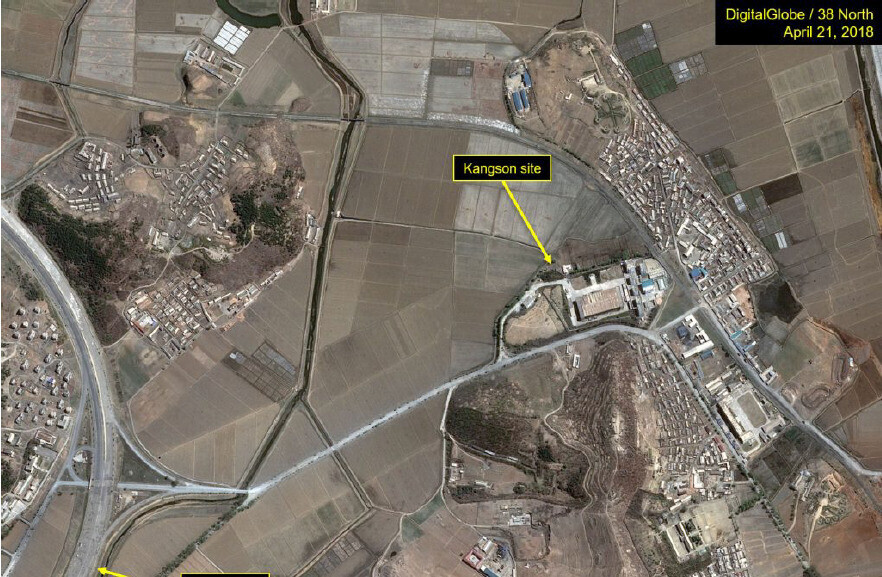hankyoreh
Links to other country sites 다른 나라 사이트 링크
IAEA suspects Kangson facility of enriched uranium production

The Kangson facility on the outskirts of Pyongyang — the immediate cause of the breakdown of negotiations between North Korea and the US during their Hanoi summit in February 2019 — is connected to nuclear activity, the International Atomic Energy Agency said.
IAEA Director General Rafael Grossi drew the connection during a press conference following a meeting of the IAEA Board of Governors in Vienna, Austria, on Nov. 18. “We are trying to finetune the analysis on Kangson, which is another site. In the beginning, we were a bit more prudent, but with further analysis we can see that this is a relevant place where [nuclear] activity is taking place,” he said.
When the IAEA returns to North Korea, Grossi said, “We will have in front of us a much wider set of facilities and places to visit. So it’s good that we start to get a feel of what could be taking place at different parts of the country.”
The IAEA made its first mention of Kangson in a Sept. 3 report titled “Application of Safeguards in the Democratic People’s Republic of Korea.” Based on “satellite imagery and open source information,” the IAEA concluded that “the construction of this complex at Kangson took place before the construction of the reported centrifuge [uranium] enrichment facility at Yongbyon, with which it shares some characteristics.”
But the report sought to avoid hasty conclusions, using conditional constructions such as “if the Kangson complex is a centrifuge enrichment facility.”

Grossi’s remarks on Wednesday go one step further than the IAEA’s Sept. 3 report. They can be taken to mean that the IAEA regards the Kangson facility as being the nuclear facility the US wanted to shut down along with Yongbyon. (North Korea has never acknowledged the existence of this additional facility.) In his opening remarks before the board meeting, Grossi reiterated his view that these nuclear activities raise serious concerns that North Korea is in breach of UN Security Council resolutions.
Kangson may have been in operation as early as 2003The existence of the Kangson facility first came to light at a sensitive time shortly after the first North Korea-US summit, held in Singapore in June 2018. In a story that ran on July 13, about a month after the summit, US-based website The Diplomat reported that the Kangson facility might have been in operation since 2003, drawing upon satellite imagery and citing analysts.
In October 2010, North Korea opened up its Yongbyon nuclear complex — which is capable of producing highly enriched uranium, a material used to make nuclear weapons — to North Korean nuclear expert Siegfried Hecker. But since then, it has kept mum about the existence of other such facilities. Some suspected at the time of The Diplomat’s report that US intelligence agencies had deliberately leaked the information about the Kangson facility in an attempt to stymie progress in the North Korea-US nuclear talks.
The existence of Kangson, which came to symbolize US demands that went beyond Yongbyon, ended up being the decisive factor in the rupture of the second North Korea-US summit, held in Hanoi in late February 2019. In his book “Rage,” published this past September, American journalist Bob Woodward vividly described a scene in which Trump rejected Kim Jong-un’s offer to shut down the Yongbyon nuclear complex in exchange for relief from UN Security Council sanctions.
Trump reportedly told Kim that one facility wasn’t enough and that he wanted five shut down. When Kim refused to back down, insisting that Yongbyon was the North’s biggest facility, Trump walked away from the negotiations, remarking that Kim wasn’t ready to make a deal.
By Gil Yun-hyung, staff reporter
Please direct comments or questions to [english@hani.co.kr]

Editorial・opinion
![[Guest essay] The real reason Korea’s new right wants to dub Rhee a founding father [Guest essay] The real reason Korea’s new right wants to dub Rhee a founding father](https://flexible.img.hani.co.kr/flexible/normal/500/300/imgdb/original/2024/0423/8317138574257878.jpg) [Guest essay] The real reason Korea’s new right wants to dub Rhee a founding father
[Guest essay] The real reason Korea’s new right wants to dub Rhee a founding father![[Column] ‘Choson’: Is it time we start referring to N. Korea in its own terms? [Column] ‘Choson’: Is it time we start referring to N. Korea in its own terms?](https://flexible.img.hani.co.kr/flexible/normal/500/300/imgdb/original/2024/0423/3617138579390322.jpg) [Column] ‘Choson’: Is it time we start referring to N. Korea in its own terms?
[Column] ‘Choson’: Is it time we start referring to N. Korea in its own terms?- [Editorial] Japan’s rewriting of history with Korea has gone too far
- [Column] The president’s questionable capacity for dialogue
- [Column] Are chaebol firms just pizza pies for families to divvy up as they please?
- [Column] Has Korea, too, crossed the Rubicon on China?
- [Correspondent’s column] In Japan’s alliance with US, echoes of its past alliances with UK
- [Editorial] Does Yoon think the Korean public is wrong?
- [Editorial] As it bolsters its alliance with US, Japan must be accountable for past
- [Guest essay] Amending the Constitution is Yoon’s key to leaving office in public’s good graces
Most viewed articles
- 1[Editorial] Japan’s rewriting of history with Korea has gone too far
- 2Samsung barricades office as unionized workers strike for better conditions
- 3[Column] ‘Choson’: Is it time we start referring to N. Korea in its own terms?
- 4Why Korea shouldn’t welcome Japan’s newly beefed up defense cooperation with US
- 5[Column] The clock is ticking for Korea’s first lady
- 6[Guest essay] The real reason Korea’s new right wants to dub Rhee a founding father
- 7Korean government’s compromise plan for medical reform swiftly rejected by doctors
- 8[Reporter’s notebook] Did playing favorites with US, Japan fail to earn Yoon a G7 summit invite?
- 9[Column] The president’s questionable capacity for dialogue
- 10Senior doctors cut hours, prepare to resign as government refuses to scrap medical reform plan